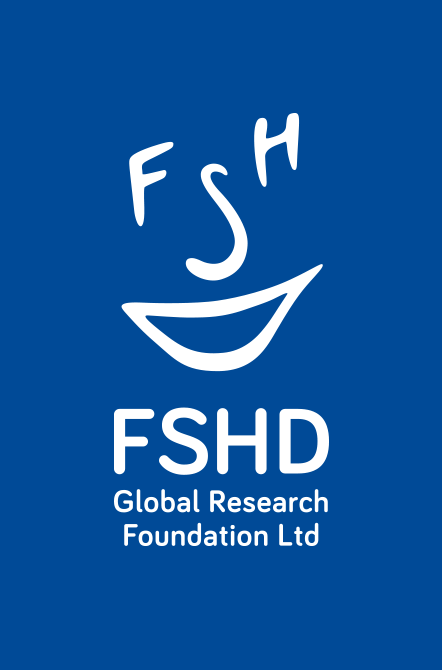GRANT 32
Research Institution: University of Calgary, Calgary, Alberta, Canada & Royal Childrens Hospital, Melbourne, Australia
Principle Investigator: Dr. Jean Mah in collaboration with Prof. Monique Ryan
Type: Collaboration
Project title: “A multicenter natural history and biomarkers study of infantile onset FSHD”
Status: Active
Summary
The baseline motor performance of 53 study participants with infantile FSHD have been studied and documented.
Consistent with previous reports, age, gender, and the size of D4Z4 repeats are associated with disease severity. Earlier onset of facial weakness in the participants was associated with a greater degree of total muscle weakness. The rate at which motor function changes will be determined by follow-up evaluations.
Speech impairment was a very common feature for participants with early onset FSHD. We identified the maximum phonation duration (MPD) as a sensitive tool for identifying speech-related issues in FSHD. We recommend affected individuals to seek professional counseling and to develop strategies to minimize voice strain and fatigue.
Remaining baseline data, including hearing, cognition, and ophthalmologic findings among the infantile FSHD cohort will be reported once further analysis has been undertaken.
Baseline samples from some participants were found to have a higher degree of hypomethylation which resembles the combined effects of Type 1 and Type 2 mutations. Additional samples should help verify this intriguing observation
The longitudinal study protocol received ethics approval by the University of Calgary and the Children’s National Medical Center and the protocol and operational manual have been disseminated to the twelve participating CINRG sites. Some sites are still undertaking negotiations to begin recruitment however, we anticipate having the first patient enrolled by April 2016.
A potential biomarker has been identified that significantly correlates with disease severity. Results were presented at the 2015 FSHD International Research Consortium Meeting in Boston, MA, and a manuscript is being prepared for publication. The mRNA expression profiling study of blood samples collected from affected individuals with early onset FSHD is underway. Baseline data indicated unique molecular profile that can potentially be useful as biomarkers for disease progression. To extend the expression profiling study to all 48 samples collected, we submitted a grant application to the US FSH society in 2015; however it was not funded. In the longitudinal study, we will include healthy controls in the protocol to serve as comparison for the biomarker studies. We would like to allocate $30,000 CND (out of the initial installment of $45,045.45 CND from FSHDGRF) to Dr. Chen’s lab to allow for the collection and storage of blood samples for biomarker discovery. Additional funding (estimated at 120K Australian dollars including microarray profiling for 48 FSHD and 10 control samples and data validation) will be needed to continue the expression profiling and biomarker studies in infantile FSHD.
PROGRESS REPORTS
Update June 2016
The baseline motor and speech performance of 53 study participants with infantile FSHD were presented at the 14th International Congress of Neuromuscular Diseases on July 7, 2016.
At enrollment, the average age of the study subjects was 23 years old. Despite their young age, one-third of the participants required a wheelchair for assisted mobility. Their ability to perform day to day activities such as walking or climbing stairs declined with increasing disease severity. The age at onset of facial weakness appeared to be predictive of disease severity; those with earlier onset facial weakness seemed to have more muscle weakness.
Looking ahead, it will be meaningful for researchers to study the rate of change in muscle strength and function among individuals with early onset FSHD. For each participant, we plan to have 3 additional assessments approximately every six month as part of a long-term follow-up study. We hope to compare the results to those with later onset disease. We have begun enrollment for the longitudinal study in Calgary, Alberta, Canada and other CINRG sites will follow shortly.
As well, speech was frequently affected among participants with early onset FSHD. We were able to identify the maximum phonation duration (MPD) as a sensitive research tool to identify speech-related issues in FSHD. The degree of speech impairment appeared to correspond with disease severity.
We have identified a novel biomarker that significantly correlated with disease severity in FSHD. Furthermore, we hope to identify unique molecular profile that can be useful as biomarkers for disease progression. Thank you for your interest and support of this team project.
Update January 2017
The early onset FSHD study continues to enroll participants across the globe as part of a long term follow-up study, thanks to the financial support from the FSHD Global Research Foundation (FSHDGRF) as well as other research partners.
In addition to Calgary Canada, the study sites that are now active include Pittsburgh, St. Louis, and Washington DC in the United States, as well as Newcastle in the United Kingdom, and Melbourne in Australia. Each participant will have 3 clinical assessments approximately every six month as part of a longitudinal study.
The study will also collect blood sample to look at markers of disease for FSHD. We hope to find unique clinical and molecular profile that can be used to measure disease progression in FSHD.
Update July 2017
To date, the early onset FSHD study have enrolled 16 participants across the globe as part of a long term follow-up study. We hope to understand the rate of change in motor function and other health-related quality of life measures among the participants with early onset FSHD. Further enrollment is on hold, pending on review of preliminary data from the follow up assessments.
In addition, using blood samples from the participants, we have been looking for biomarker candidates for FSHD. A biomarker is a biological characteristic that can be objectively measured and evaluated as an indicator of normal biological processes, pathogenic processes, or pharmacologic responses to a therapeutic intervention. A major advantage of having measurable biomarkers from blood samples is to provide safer and low-cost means to determine whether a potential treatment is effective in clinical studies. We have been using several methods to identify different types of molecules in the blood samples, which can potentially be used as biomarkers. At this moment, we screened proteins in the blood samples and found 19 candidates. One of the protein, glutathione peroxidase 3 (GPX3), was further investigated using more samples and the results confirmed the difference between samples from individuals with FSHD and healthy controls. In addition, we used cutting-edge technologies to determine RNA changes in the blood samples and identified activities associated with specific types of immune cells that were different between samples collected from affected individuals and controls. This finding may provide important insights to the disease mechanisms in FSHD. The study will also collect blood sample to look at markers of disease progression for FSHD. We will need to obtain additional funding for the follow-up studies. We hope to find unique clinical and molecular profile that can be used to measure disease progression in FSHD.




